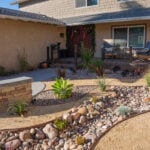The idea of sustainable landscaping pops out as a ray of hope among the bustle of city life, in the middle of busy metropolitan landscapes where concrete buildings soar and green areas are few. It promises regeneration and renewal. The need for greenery and sustainability is more important than ever in these concrete jungles where the constant hum of traffic muffles the whispers of nature.
But there is promise among the sprawling concrete. We have the ability to turn desolate areas into verdant, lush havens that are good for the environment and for people by reinventing urban surroundings via eco-conscious design and creative methods. A roadmap for taking back our cities, bringing our urban ecosystems back into balance, and encouraging a closer relationship with nature is provided by sustainable landscaping.
Come along as we set out to investigate the revolutionary possibilities of sustainable landscaping in city settings. You will learn how creative design approaches and nature-based interventions can revitalize our cities and make them healthier, more living places for all, from green roofs and vertical gardens to community parks and urban farms. Together, let’s rethink urban life and build a more sustainable, greener future for future generations.
Embracing Green Infrastructure:
In order to control stormwater, lessen the impacts of heat islands, and enhance air quality, green infrastructure refers to the deliberate integration of natural components into urban settings, such as plants, trees, and permeable surfaces. Cities may lessen the negative effects of urbanization while improving the well-being of citizens and animals by implementing green roofs, rain gardens, bioswales, and urban forests into the built environment.
Maximizing Vertical Greenery:
Urban environments can benefit from the space-saving solution provided by vertical greenery systems, such as living walls and green facades. In addition to adding aesthetic value to concrete walls and buildings, these vertical gardens have other positive environmental effects, such as less noise, better air quality, and lessening of urban heat islands. Cities may improve biodiversity and attractiveness while advancing sustainability by utilizing vertical areas.
Urban Food Gardens:
Sustainable landscaping greatly benefits from urban agriculture as it lowers food miles, increases community involvement, and makes fresh, locally farmed food accessible. Urban food gardens support food security, social integration, and ecological resilience in cities through communal allotments, rooftop gardens, and guerilla gardening projects. Urban regions may become more resilient to global food supply concerns and self-sufficient by reusing unused spaces for food production.
Prioritizing Native Plantings:
natural plants, which provide several advantages including insect resistance, drought tolerance, and the restoration of natural wildlife habitat, are the foundation of sustainable landscaping. Cities may conserve water, lower maintenance costs, and promote biodiversity by giving native flora priority in urban green areas. Native gardens reconnect urbanites with their local ecosystems and help them develop a greater appreciation for nature, making them useful teaching tools.
Smart Irrigation Techniques:
Sustainable landscaping must prioritize water conservation, especially in metropolitan areas where water resources are scarce. Cities may reduce runoff and maximize water consumption by using smart irrigation techniques. Like drip irrigation, soil moisture monitors, and rainwater collection systems into place. These innovations not only conserve water but lower utility bills. They also encourage plant growth that is more resilient to drought.
Cultivating Greener Cities
For the sake of both the world and the well-being of urban dwellers. The transformation of a concrete jungle into a green sanctuary is not just a pipe dream. The decisions we make now will influence the cities of the future as we stand at a crossroads in urban development. In order to build resilient, livable urban settings that coexist peacefully with the natural world. Adopting sustainable landscaping methods is not an option—it is a need.
We can improve livability, lessen environmental problems, and promote a stronger connection to nature. By integrating green roofs, vertical gardens, urban food forests, and native species into our urban landscapes. Sustainable landscaping provides a method to build thriving, healthy communities where nature and humans coexist together. Hence, green areas serve as havens from the rush of daily life.
Let’s embrace the chance to create greener, healthier, and more sustainable cities in the future. One green space at a time, by focusing on the future. We can leave a legacy of vibrant, resilient cities that benefit both the present and future generations. Therefore, banding together to redesign our urban environments and give sustainability a top priority in urban planning and design. Accepting the challenge will allow us to make our cities global role models for sustainability and environmental management.






